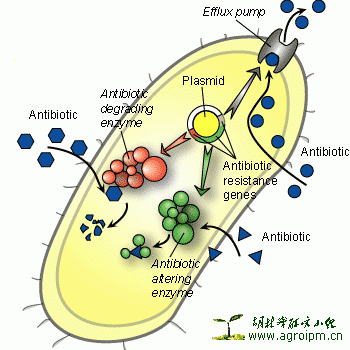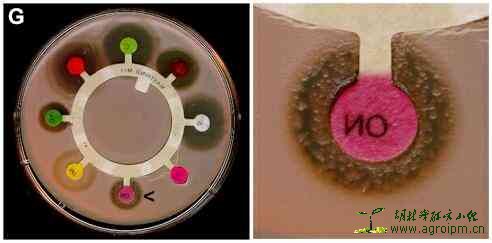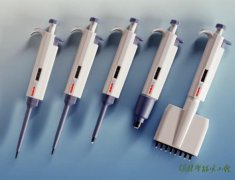The most common mode is enzymatic inactivation of the antibiotic. An existing cellular enzyme is modified to react with the antibiotic in such a way that it no longer affects the microorganism. An alternative strategy utilized by many bacteria is the alteration of the antibiotic target site. These and other mechanisms are shown in the the figure and accompanying table below.

| Antibiotic | Method of resistance |
| Chloramphenicol | reduced uptake into cell |
| Tetracycline | active efflux from the cell |
| β-lactams, Erythromycin, Lincomycin | eliminates or reduces binding of antibiotic to cell target |
| β-lactams, Aminoglycosides, Chloramphenicol | enzymatic cleavage or modification to inactivate antibiotic molecule |
| Sulfonamides, Trimethoprim | metabolic bypass of inhibited reaction |
| Sulfonamides, Trimethoprim | overproduction of antibiotic target (titration) |
Antibiotic resistance in bacteria may be an inherent trait of the organism (e.g. a particular type of cell wall structure) that renders it naturally resistant, or it may be acquired by means of mutation in its own DNA or acquisition of resistance-conferring DNA from another source.
Inherent (natural) resistance.
Bacteria may be inherently resistant to an antibiotic. For example, an organism lacks a transport system for an antibiotic; or an organism lacks the target of the antibiotic molecule; or, as in the case of Gram-negative bacteria, the cell wall is covered with an outer membrane that establishes a permeability barrier against the antibiotic.
Acquired resistance.
Several mechanisms are developed by bacteria in order to acquire resistance to antibiotics. All require either the modification of existing genetic material or the acquisition of new genetic material from another source.
Vertical gene transfer
The spontaneous mutation frequency for antibiotic resistance is on the order of about of about 10-8- 10-9. This means that one in every every 108- 109 bacteria in an infection will develop resistance through the process of mutation. In E. coli, it has been estimated that streptomycin resistance is acquired at a rate of approximately 10-9 when exposed to high concentrations of streptomycin. Although mutation is a very rare event, the very fast growth rate of bacteria and the absolute number of cells attained means that it doesn't take long before resistance is developed in a population.
Once the resistance genes have developed, they are transferred directly to all the bacteria's progeny during DNA replication. This is known as vertical gene transfer or vertical evolution. The process is strictly a matter of Darwinian evolution driven by principles of natural selection: a spontaneous mutation in the bacterial chromosome imparts resistance to a member of the bacterial population. In the selective environment of the antibiotic, the wild type (non mutants) are killed and the resistant mutant is allowed to grow and flourish
Horizontal gene transfer
Another mechanism beyond spontaneous mutation is responsible for the acquisition of antibiotic resistance. Lateral or horizontal gene transfer (HGT) is a process whereby genetic material contained in small packets of DNA can be transferred between individual bacteria of the same species or even between different species.
There are at least three possible mechanisms of HGT, equivalent to the three processes of genetic exchange in bacteria. These are transduction, transformation or conjugation. Conjugation occurs when there is direct cell-cell contact between two bacteria (which need not be closely related) and transfer of small pieces of DNA called plasmids takes place. This is thought to be the main mechanism of HGT.
Transformation is a process where parts of DNA are taken up by the bacteria from the external environment. This DNA is normally present in the external environment due to the death and lysis of another bacterium.
Transduction occurs when bacteria-specific viruses (bacteriophages) transfer DNA between two closely related bacteria.



量程的调节 调节量程时,如果要从大体积调为小体积,则按照正常的调节方法,逆时针旋转旋钮即可;但如果要从小体积调为大体积时,则...

Two-dimensional thin-layer chromatography in the analysis of secondary plant metabolites ukas z Ciela , Monika Waksmundzka-H ajnos , Drugs, derived from medicinal plants, have been ...
1 什么是扫描电子显微镜(SEM) Scanning Electron Microscope(SEM)扫描型电子显微镜是由真空系统、 高压电源、高灵敏度增幅器获取样品表面图像的...

环己烷(CYH)、环己酮(CYC)、二丙酮醇(DAA)、四氢呋喃(THF)、二甲基甲酰胺(DMF)、二甲亚砜(DMSO)、甲基丙烯酸甲酯(MMA). (A)酯类 ESTERS 乙酸甲酯 MA...